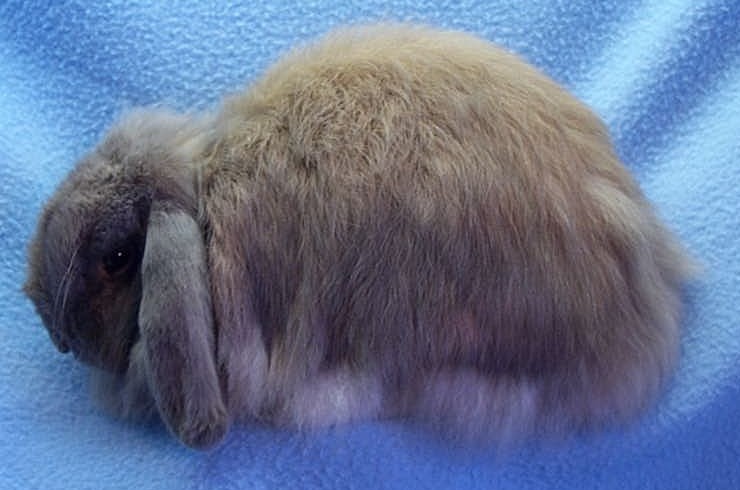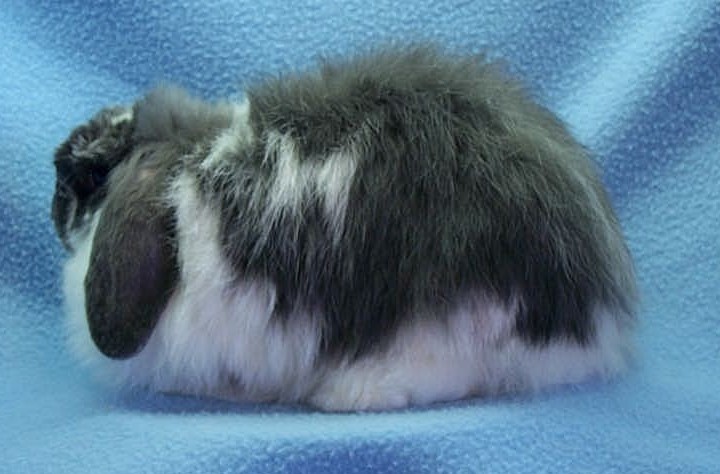

CASHMERE & MINI CASHMERE LOP - Nikki White (Reguli Cavy & rabbit stud)


Basically the Standard Cashmere Lop is the long-haired cousin of the Dwarf Lop and the Mini Cashmere Lop is the longhaired cousin of the Mini Lop. They have the same outgoing, friendly personalities and make good pets as long as you take the time to keep their coat matt free. Fortunately, this isn't hard and is nowhere as time-consuming as for Angoras (or Persian cats).
Standard Cashmere: The BRC standard calls for a bold, thickset firm body, short and broad with little visible neck and everything pretty much the same as for a Dwarf Lop. The coat, however, is the difference. The top coat is to be longer and heavier than the undercoat with plenty of longer, stronger guard hairs. The coat should be about 3.81 to 5.08 cm long and hang down naturally. Evenness is more important than length, as in other longhaired animals such as the 6 longhaired cavy breeds. Weight is between 1.92 kg (minimum) and 21.38 kg (maximum) with 2.15 kg being the ideal. Faults are the usual - white hairs in solid colours and white toenails in coloured animals. Disqualifications include being over the maximum weight or under the minimum weight, waviness in coat, malocclusion or deformities.
Mini Cashmere: The BRC standard is as above except the weight is 1.6 kg maximum.
HISTORY
Standard Cashmere Lop: Their origin is very similar to that of the Somali cat. Just as longhaired "sports" turned up in litters of Abyssinians (and were quietly swept "under the carpet" until some breeders decided to develop them as a separate breed), so the odd long-haired kit turned up in litters of Dwarf Lops (and doubtless were petted out like the proto-Somalis) until some breeders decided to develop them as a separate breed. Exactly when this happened is unknown, however, by the early 1980s, a Mrs I. A. Plant applied to the Rare Varieties Club to have the breed accepted under the name of 'Thistledown'. As this was thought to sound too much like a stud name, the application was turned down. Undeterred, Mrs Plant and fellow breeders continued their work and by the mid-80s had formed the National Cashmere Lop Club and the club, the breed name and the standard were accepted by the BRC.
Mini Cashmere Lop: Probably began the same way, long-haired kits turning up in litters of the smaller Dwarf Lops then being bred down in the 1980s. It was not until the late 1980s that Jane Bramley bred the first litter of Mini Cashmeres. The progress was slowed down by the emergence of the Mini Lop and the efforts to merge to two standards into one and the subsequent Mini Lop craze. once that settled down, breeders could turn their attention to getting a standard accepted by the BRC which was achieved in 2000. The breed is looked after by the National Cashmere Lop Club.
SO, A CASHMERE ORE MINI CASHMERE LOP, THEN?
They have great personalities and, if possible, are even more laid back than the Dwarf Lop. Occasionally you get some cranky ones but that's just bad breeding or bad luck as the vast majority make wonderful pets. You do have to consider whether you want them as a pet or for show and make it clear to the breeder as she will give you extra advice on preparing them for showing. If just as a pet, you still need to keep the coat matt free. Those with good strong guard hairs in their coats are less problematic than those with fuzzier less guardy coats. I used o run mine on carpet with a litter tray and had very little trouble with tangles. Wood shavings or paper or wood pellets are not ideal as they can get caught in the coat as can hay. So will need to spend some extra time brushing them, once or twice a week if a pet, more frequently oif for show.
WHAT TO LOOK FOR
Standard Cashmere: Pretty much the same as for a Dwarf Lop but look out for the coat. It should be dense and silky with no matts or tangles and feel slightly coarse when stroked from the shoulders down toward the undercoat. Mini Cashmere: pretty much the same as for the Mini Lop but again, watch out for the coat.
HOUSING AND CARE
Standard Cashmere: Being a similar size to the Dwarf Lop, they need a similar cage size 10-120 x 50 x 50 or 80 x 80 x 60 cm. Mini Cashmere being a small rabbit, the Mini Cashmere Lop needs a cage 50 x 50 or 80 x 80 x 60. The floor should be solid as wire can lead to sore hocks. Geoff Russell recommends heavy sawdust but that isn't readily available here these days and many breeders frown on it because of the dust. Carpet squares or vet-bed (dri-bed) are possibilities. OzPet wood pellets are not too bad but tend to stain when they break down.Or you could construct a frame as used by Angora breeders and exhibitors made of wood with wire stretched over it. This is certainly useful as an insert in their travel cage for shows. Grooming for shows should be little and often, so that whereas a Dwarf Lop can be taken out the day before and given a once-over, for these you need to start a week or so before the show. Geoff Russell recommends accustoming kits to grooming by giving them daily session of 10 minutes (this also because kitten coats are the most demanding), then move 20 minute sessions daily. Once the adult coat comes through this can be reduced to twice weekly sessions of 20-30 minutes and finally to once weekly session of 30 minutes. He recommend using a cat moult comb (one with tines of different length) Feed is as for other breeds - pellets, mix, fresh fruit and veg, as treats. Don't over feed them as like all Lops, they have the Greedy Gene.
FURTHER READING
British Rabbit Council, Standards of Rabbit Breeds 3rd ed. 2011-2016.
"Lop lore 5: Cashmere Lop" Fur & Feather Jan. 2005 p. 62
Russell, Geoff, A Fancier's Guide to the Lop Rabbit. Ipswich, K.D.S., 2004
Russell, Geoff, Mini Encyclopeda of Rabbit Breeds & Care. Dorking, Interpet Publishing, 2008
Sandford, J.C., The Domestic Rabbit 5th ed. Blackwell, Science, 1996
Verhoef-Verhallen, Esther, Encyclopaedia of Rabbits and Rodents. Lisse, Rebo Productions, 1998
Vriends-Parent, Lucia, The New Rabbit Handbook. Hauppage, NY, Barrons, 1989
Whitman, Bob D., Domestic Rabbits & Their Histories: Breeds of the World. Leawood, KS : Leathers Publishing, 2004
Williams, A.E. Ted, Rabbit Breeding for Perfection. Melbourne, AE Williams, 1992.
ORGANISATIONS
National Cashmere Lop Club (UK)
FURTHER READING
Russell, Geoff, A Fancier's Guide to the Lop Rabbit. Ipswich, K.D.S. Publishing, 2004
Whitman, Bob D., Domestic Rabbits & Their Histories: Breeds of the World. Leawood, KS : Leathers Publishing, 2004.